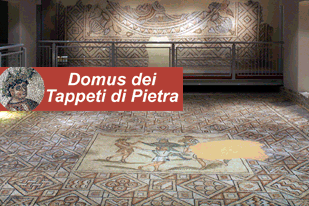The leadership of the Ravenna Capital.




The leadership of the Ravenna Capital. Hotels in the centre of Ravenna.
Photo:1) S.Apollinare Nuovo, "Palatium" regal parts of the urban backdrop of Ravenna. , 2) S.Apollinare Nuovo, the "Civitas Classis" with a view of the port, the walls and the urban landscape,3) Ravenna in the first roman period (jellow) in the gothic-bysantine period (violet) religious foundation zone from the IV century (green),4)excavation of the Via Popilia, south of Ravenna
In a period of 150 years Ravenna stood out as the leading town of the west.
In 402 Onorio (father on his fathers side of Galla Placidia) the imperial seat , was transferred here as it was deemed preferable to Milan for safety reasons.
Theodore the Great, in 493, proclaimed it to be the capital of his “Roman-barbarian” kingdom.
On the victorious conclusion of the war against the Goths (535-553), Giustiniano re-united the Empire and Ravenna became the seat of the Byzantine prefecture of Italy.
The reason for its popularity being largely due to its environmental features: Ravenna became the “queen” of the Adriatic – in the same way as those that became before it Spina, Adria, Aquileia – for three important reasons.
It could not be attacked from the sea (with five kilometres of dry beach which prevented any approach beyond the sea tide cycles) as well as being attack proof from the land (being surrounded by a lagoon, the main access to Ravenna being located to the south along the via Popilia – that linked Rimini to Aquileia: a precarious road which was modified several times according to the shifts of the costal dunes).
Finally, Ravenna was located at the mouth of a deeper waterway: the longest branch of the Po river delta which flowed through marsh lands, along which raw commodities travelled (especially timber) and goods destined to the North-eastern European market.
Behind the town, as early as the first century after Christ, when Augustus positioned his ships of the Imperial military fleet, the so-called “ Agricultural Romagna” was flourishing (from Cesena to Russi), which was capable of offering the cosmopolitan population concentrated around the port of Classe, a diet that was based on cereals, meat and wine in order to supplement that from the sea, consisting of, seafood and fine sand sea fish.
The physiognomy of Ravenna during the first centuries of the imperial era was very similar to that of Venice, with the main routes being by water and the urban buildings being supported by raised structures made of alder wood (the same wood as used in Spina).
During this period a part of the town was regularly planned with an orthogonal plan: at it was at the southern edges of the same that the Cathedral and Bishopric were erected at the end of the 5th century.
The following expansion – once Ravenna became the Imperial capital – was not in the form of the addition of urban suburbs, but in a horizontal direction, for obvious geographic motives, especially along the axis of the Popilia.
The result was the creation of a town that was unique in Italy, a kind of polycentric agglomerate, which combined the town centre with the port are of Classe bound in the middle by the zone known as “Cesarea”.
Cesarea was protected by a palisade, while Ravenna and Classe were surrounded by walls at the end of the 6th century.
Prof.Gianni Morelli
The pleasure of fine accommodation in the centre of Ravenna: we recommend the Fabbri hotels for a pleasant stay as follows:
The Centrale Byron Hotel, 3-star hotel in the centre of Ravenna, close to the main momuments;
The Bisanzio Hotel, 4-star hotel in the centre of Ravenna, close to the main momuments;
Once you have reached the hotel and parked your car, forget it and walk everywhere, because everything is within walking distance.
© reserved copyright





